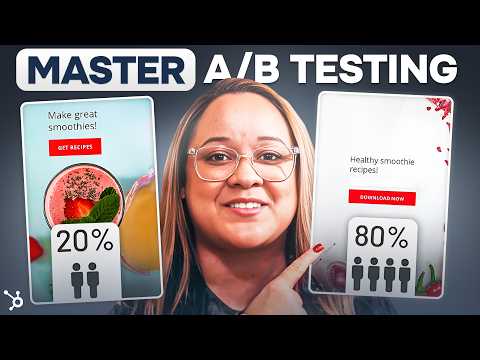Unlocking the Power of A/B Testing for Website Optimization

In the fast-paced digital era, where every click counts, understanding what resonates with your audience is key to digital success. Have you ever wondered why some website changes skyrocket your conversion rates while others fall flat? Enter A/B testing, the secret weapon savvy marketers use to refine their websites.
Imagine running a live experiment on your website visitors without them even knowing. A/B testing allows you to do just that, providing insights into what drives engagement and helps you make data-driven decisions.
By testing different versions of web pages, buttons, or banners, you can uncover user preferences and optimize the user experience. This technique doesn’t just boost conversion rates—it also reduces bounce rates and enhances user satisfaction. That’s the beauty of A/B testing: small tweaks can lead to big results.
Dive in, and discover how to harness the full potential of A/B testing to unlock new heights for your website’s performance.
Understanding A/B Testing and Its Importance
A/B testing, at its core, is a method of comparing two versions of a webpage or app against each other to determine which one performs better. It’s a powerful tool for making informed decisions that drive measurable improvements.
In a typical A/B test, you divide your audience into two groups: Group A sees the original version, while Group B encounters a variation. By analyzing how each group interacts, you can gather valuable insights into user preferences and behaviors.
The importance of A/B testing cannot be overstated. It takes the guesswork out of optimization, allowing you to rely on data rather than assumptions. This means fewer risks when implementing changes and a higher likelihood of positive outcomes.
The iterative nature of A/B testing means it’s both strategic and scientific. By continuously testing and refining, you adapt to changing user needs and market trends, ensuring that your website remains relevant and competitive.
Embrace A/B testing as an essential part of your optimization toolkit, and watch as it transforms your approach to building engaging, user-centered digital experiences.
Setting Clear Goals for Your A/B Testing Experiments
Before diving into A/B testing, it’s crucial to establish clear, actionable goals. Think of these as your guiding stars, keeping your experiments focused and meaningful.
Start by identifying what you want to improve. Is it click-through rates on a call-to-action button, the average time spent on a page, or the overall conversion rate? Pinpointing specific metrics helps measure success and ensures your tests yield actionable insights.
Prioritizing Your Objectives
Once you have a list of possible goals, prioritize them based on their potential impact and alignment with broader business objectives. Focusing on high-impact areas ensures that your efforts deliver the greatest value, maximizing your resource investment.
Remember, clarity is key. Vague goals like “improve user engagement” should be broken down into specific, measurable objectives. This precision lets you track progress and celebrate wins as they occur.
Setting these goals is more than just a preliminary step—it shapes the entire testing process. By anchoring your experiments with clear objectives, you’re setting yourself up for success, ensuring each test contributes to your website’s overall growth and improvement.
Creating Effective A/B Testing Variations
Crafting impactful variations is the heart of a successful A/B test. The key is knowing what elements to change and ensuring those changes are both meaningful and measurable.
Start by analyzing your current webpage to identify potential areas for improvement. This could be anything from headlines, images, colors, or call-to-action buttons. The goal is to make changes that could realistically affect user behavior.
Focusing on Simplicity
When creating variations, simplicity is your ally. It’s tempting to tweak multiple elements at once, but this can muddy the waters when interpreting results. By isolating one variable per test, you can clearly attribute changes in performance to the specific tweak you implemented.
Don’t shy away from bold changes. Sometimes, a dramatic shift in design or messaging can yield surprising results, capturing user attention in unexpected ways. However, ensure these changes align with your brand identity and user expectations to maintain trust.
Each variation should have a hypothesis—a clear assumption of why this change will improve the metric you’re targeting. This not only guides your design choices but also provides a learning framework for future tests, regardless of the outcome. Keep refining, and let user feedback shape your path forward.
Interpreting A/B Testing Results and Making Data-Driven Decisions
Once you’ve run your A/B tests, the real work begins: interpreting the results to inform your next steps. It’s not just about identifying which variation performed better, but understanding why it did.
Analyze the data with a clear focus on the goals you initially set. Look for statistically significant results to ensure that any differences observed are not due to chance. Remember, reaching a statistical conclusion is essential before declaring a winner.
Beyond the Surface Numbers
Go beyond the basic metrics. Delve deeper into user behavior to uncover patterns that could impact your conclusions. For instance, did a particular user segment respond positively to a change? These insights can reveal opportunities for further targeted optimization.
After analyzing the data, it’s time for decisive action. Whether it’s implementing the winning variation, iterating for more nuanced tests, or even re-evaluating underperforming elements, your decisions should be grounded in the data.
Remember, the goal is continuous improvement. Even tests that don’t produce clear winners can offer valuable insights, guiding the direction of future experiments. Keep iterating, and let these insights drive your strategy, ensuring your website continually evolves with user needs and preferences.

Optimizing Your Website Based on A/B Testing Insights
Armed with the insights gathered from A/B testing, it’s time to turn those learnings into tangible website optimizations. This is where insights translate into action, setting the stage for enhanced user experiences and increased conversions.
Begin by implementing the changes from winning variations. Ensure that these updates align with the overall user journey, maintaining consistency across different pages and elements. This alignment fosters a seamless experience, building trust with your audience.
Iteration and Continuous Improvement
Optimization is not a one-time task but an ongoing journey. Use the insights from one test to inform the next. Continually revisit elements that show room for growth and test alternative strategies to uncover new opportunities.
Monitor performance regularly to ensure new implementations are delivering the desired results. This vigilant oversight allows you to make swift adjustments if necessary, ensuring your website evolves in response to real user feedback.
The key to successful optimization is being open to change. Let the data guide your decisions, and don’t be afraid to challenge assumptions. By fostering a culture of continuous testing and learning, your website can adapt and thrive in the ever-changing digital landscape.
Conclusion: Leveraging A/B Testing for Continuous Website Improvement
In the quest for website excellence, A/B testing emerges as an indispensable ally. By harnessing its power, you’re not just making changes; you’re making informed decisions grounded in real user data. This scientific approach transforms guesswork into a strategic pathway toward optimization.
Throughout this journey, setting clear goals provides a solid foundation, guiding your experiments with precision. Crafting effective variations allows you to explore user preferences without straying from your core objectives. Interpreting the results with an analytical mindset ensures that your conclusions are both reliable and actionable.
However, the process doesn’t stop at analysis. The ultimate goal is to apply these insights effectively, fostering a seamless and engaging user experience. By continuously refining your approach based on results, your website becomes more intuitive and responsive to visitor needs.
Additionally, embracing a mindset of continuous improvement means acknowledging that optimization is never truly complete. The digital landscape evolves rapidly, and staying ahead requires ongoing testing and adaptation. This iterative cycle of testing, learning, and implementing creates a dynamic environment where your website can thrive.
In essence, A/B testing is about more than just numbers—it’s about understanding and enhancing your digital interactions. By leveraging A/B testing as a tool for continuous improvement, you ensure that your website remains an agile, user-focused platform capable of exceeding expectations and driving success.



